
Diane with her collaborator, Shelley Rotner.
Woof woof! Hot diggety dog!
I'm pleased as punch today to welcome back supremely talented and prolific author/illustrator Diane deGroat, who has totally gone to the dogs with fellow author Shelley Rotner to create a thoroughly delightful, tickle your funny bone picture book, Dogs Don't Brush Their Teeth.
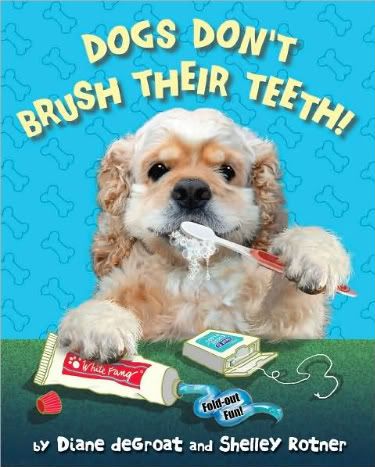
Picture book for ages 4-8, 32 pp.
Just released by Orchard/Scholastic on August 1st, this fold-out concept book combines photographs with digital art to illustrate what dogs do, and what they don't do, and has readers of all ages howling with laughter and begging for more.
You don't have to be a dog lover to appreciate these charismatic canines, who, thanks to Shelley's expert photography and Diane's clever Photoshop manipulations, can be seen doing fun things like playing tennis, eating with a knife and fork, playing in a rock band, and of course, brushing their teeth (with White Fang toothpaste, no less). The fold-out format is highly effective at keeping the suspense and surprise padding along at a good clip with nary a whimper. And if all this adorableness isn't enough, the acknowlegement page features all the dogs' names and breeds with their profile pictures. Yip!
Some of you may remember that Diane was my very first alphabet soup interviewee back in October 2007, when she stopped by to talk about the snowflake she had created for the Robert's Snow auction. That's when we all found out about this: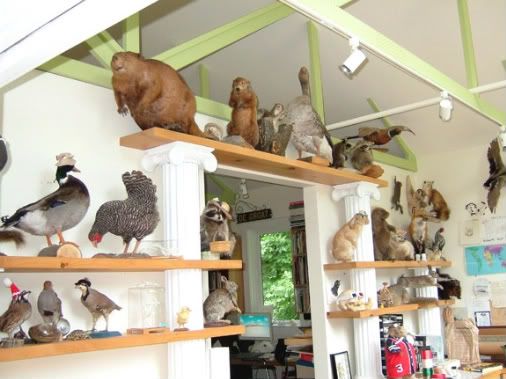
Yes, Diane's famous taxidermy collection! Quite fascinating, no? Since then, Diane has published two more titles featuring everyone's favorite possum, Gilbert, in addition to the new dogs book. So, why did Diane have to remove the canine's canines? And what other tricks did she and Shelley perform for these perky posable pups?
Sit. Stay. Read on:
Such a pleasure to have you back, Diane. How did you and Shelley come to work together on this project?
Shelley Rotner and I became friends when I moved to MA and joined the Western Massachusetts Illustrators' Guild in 1995. Shelley always had good ideas, and I was anxious to try something different from my usual picture book art. We planned a brainstorming session to find a book idea that could combine her photographs with my art. With pad and pencil in hand, we tossed a lot of ideas around. We both agreed that dogs were a good subject, but we weren't on the same page with it.
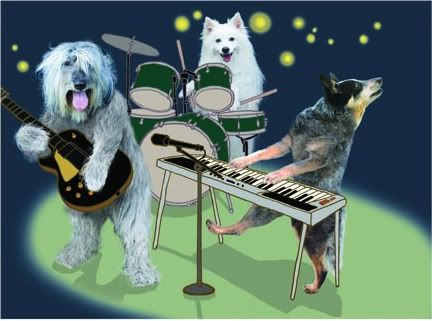
Late into the night (and after a good bottle of wine), I was still pushing for a picture book story about a lost dog, which had the potential for some interesting artwork, but the story kept falling flat. Shelley was leaning toward a concept book, as most of her books are nonfiction. Finally, Shelley came up with the "dogs do, dogs don't" idea. It sounded almost too simple, but when we started making a list of what dogs do, and the human equivalent of what they don't do, it really took shape. That was the fun part -- coming up with silly ideas. The rest was hard work!
Was this the first time both of you had worked on something like this?
It was my first collaboration, and it was Shelley's first book that was "silly," rather than serious.
How did you make the illustrations?
I made the full-sized dummy art by drawing right into my computer with my Wacom tablet. I had to figure out the best way to position the dogs in the illustrations. They had to work with the flaps closed (Dogs do . . .), and with the flaps opened (Dogs don't!). Shelley photographed the dogs as close as possible to my sketch, but of course she couldn't shoot a dog blowing a bubble or using a hula hoop!
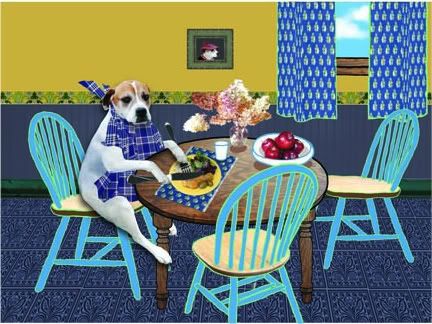
That's when Photoshop came in. I had to manipulate the photograph to look like the dog was performing a human action. Sometimes I used pieces from many different photos to do this. The harder part was figuring out what the background art should look like. There were many ways I could have handled it: collage-y, scribbly, cartoony or realistic. I had to try many different styles until I found the one that I was most comfortable with.
Do you have a favorite picture? Which one took the longest/was the most difficult?
My favorite illustration, and one of the hardest, is the dog with the braces on his teeth. I spent almost a week getting the teeth to look right!
Here's the dummy sketch with the flap opened:
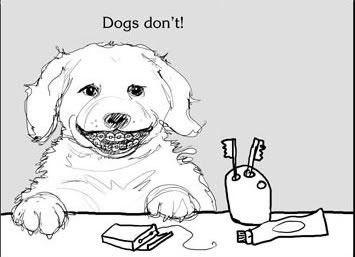
This is the photograph that Shelley took:

I scanned canine teeth from an animal anatomy book:
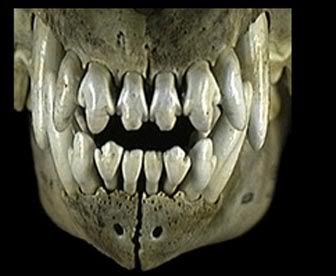
I placed them in the Cocker Spaniel's mouth. Then I drew over the teeth and added gums. I had to guess how they would fit, and what the smile would look like! I'm sure any veterinarian looking at this would cringe at its inaccuracy!

It looked really creepy, so I shortened the canine teeth and closed the mouth some:

I Googled an image of braces. Then I drew over one to make it clearer: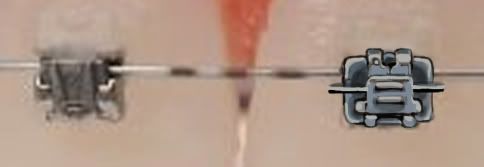
I then copied and pasted it onto each of the teeth, and added the wires.

Then I tried different backgrounds.
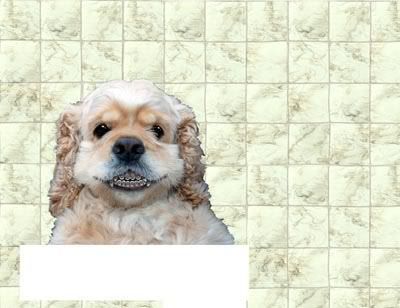
The paws came from a different dog.
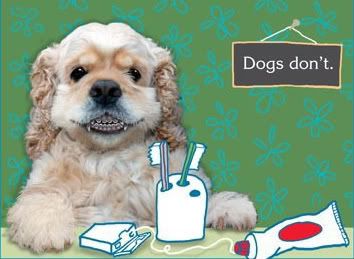
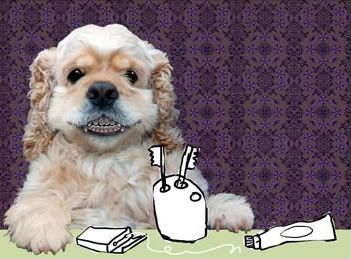
At this point, the cartoony style of drawing in the above art didn't feel right, as it was too great a contrast with the photograph. I made the drawing more realistic in the final version below, and the toothbrush was replaced with a photograph. Shelley thought the purple Victorian wallpaper in the background looked too formal; she suggested using bones instead. I drew the bones onto the background, and I agree that it looks much better. And finally, the canine teeth were removed altogether. Even though it's not anatomically correct, it doesn't look as creepy!
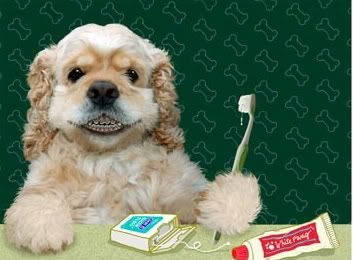
What were some of the most notable things you learned from working on this book? Any tips for other illustrators who might be interested in combining photographs with digital art?
This was my first collaboration, and it took some getting used to. But it paid off: neither Shelley nor I could have done this book by ourselves, so a collaboration really worked in this case. Artistically, I learned to take risks and to try new things that I would never have attempted with watercolor. With digital art, you can't mess up your work, so trial and error is a great way to go. I also had help from other illustrators who work more with digital art than I do. Their expertise was invaluable when I ran into a technical problem. And sometimes our illustrator's group was a good venue for suggestions and comments.
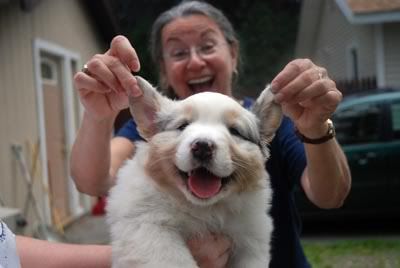
How were the dogs chosen?
Shelley had an Australian Shepherd, Ginger, who sadly passed away while we were working on this book. While walking Ginger in town or on the trails, Shelley met many other dogs and their owners. She was also acquainted with breeders and she had friends who owned dogs. There never seemed to be a lack of dogs to photograph! We tried to use breeds that best fit the activity, such as using a greyhound for the "running" art, and a bulldog for the eating scene.
Did Shelley have any especially funny/challenging/memorable incidents occur when she was photographing them?
The dogs were sometimes given treats to get them to pose. If a dog moved, or if the lighting was poor, the photo would be out of focus. They had to be shot outdoors where there was enough light, but not in the sun, which would cause strong shadows. Weather was always a factor! The owners were eager to help whenever possible. If you check the outtake slides on the website, you'll see some of the owners trying to position their dogs for Shelley. One of the hardest dogs to photograph was the pooping dog. Shelley had to follow the dog around until just the right moment!

Please tell us all about the Dogs Don't Brush Their Teeth website.
We made the website because we had a lot to share about the making of the book and about the dogs themselves. For the site, we gave each dog a profile page with his stats -- best friend, favorite toy, likes and dislikes, etc. It gives the reader a chance to see that the dogs in the books are real dogs. There are book-related activities for kids to download, too. And dog biscuit recipes!
What are you working on now?
Right now, I'm working on the 13th book in the "Gilbert and Friends" series. It's for Earth Day, and Gilbert's issue is his inability to come up with ideas (for a project). The title is a long one: Ants in Your Pants, Worms in Your Plants! (Gilbert Goes Green), (HarperCollins, 2011).
And of course we are thinking of a sequel to the dog book -- cats!
Before you go, please tell us about the new Gilbert titles that were released this year.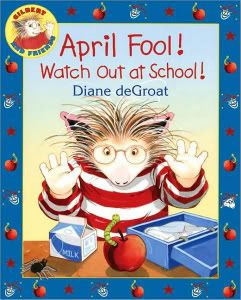
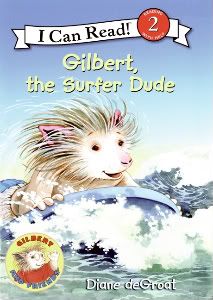
April Fool! Watch Out at School! is a little different because it has a gimmick. There are hidden "tricks" in the art that the reader has to find. (Hint: The picture of George Washington on the classroom wall is a portrait of me!) And Gilbert, The Surfer Dude is my first I Can Read book for HarperCollins. I'm running out of holidays for Gilbert's picture books, so I started a spin-off series that will cover Gilbert's everyday adventures. The second I Can Read book will be Gilbert and the Lost Tooth (2011). Again, the issues covered in these books are things that every first grader can relate to.
Thanks so much for visiting today, Diane. And thanks for writing such wonderful books! Ruff ruff!

ROLL OVER AND CLICK:
Dogs Don't Brush Their Teeth Website: You'll love all the dog profiles, process pics and downloads. You can also purchase prints, mugs and t-shirts featuring some of the illos from the book.
Booksigning Alert: Diane and Shelley will be signing books on Martha's Vineyard this weekend. Click here for their appearance schedule.
Diane deGroat Official Website.
Shelley Rotner Official Website.
Must-watch video interview with Diane over at Just One More Book: take a look at her studio and watch her draw and paint with the computer.
Online review of Dogs at Jen Robinson's Book Page.
*Spreads and photos posted by permission, copyright © 2009 Diane deGroat and Shelley Rotner, published by Orchard Books/Scholastic. All rights reserved.
Viewing: Blog Posts Tagged with: reviews and musings, Most Recent at Top [Help]
Results 1 - 2 of 2
Blog: jama rattigan's alphabet soup (Login to Add to MyJacketFlap)
JacketFlap tags: interviews, diane degroat, reviews and musings, Add a tag
Blog: jama rattigan's alphabet soup (Login to Add to MyJacketFlap)
JacketFlap tags: taste of summer, secret garden, oatcakes, reviews and musings, Add a tag
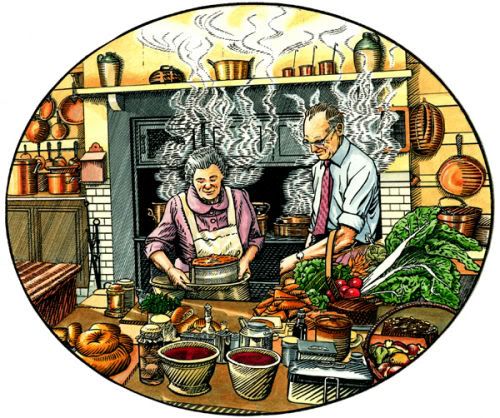
"After a few days spent almost entirely out of doors Mary wakened one morning knowing what it was to be hungry, and when she sat down to her breakfast she did not glance disdainfully at her porridge and push it away, but took up her spoon and began to eat it and went on eating it until her bowl was empty."
The Secret Garden is first and foremost about the wonder and magic of making things come alive -- the blossoming of an abandoned garden and two lonely, neglected children. But food is also magical and plays a crucial role in the story. As the flowers and plants grow, so do Mary and Colin's appetites -- and who can blame them, with pails of fresh milk, homemade cottage bread slathered with raspberry jam and marmalade, buttered crumpets, currant buns, hot oatcakes, muffins, dough-cakes, and the all-important bowl of warm porridge, sweetened with treacle or brown sugar.
Oatmeal porridge was eaten by both rich and poor in Yorkshire during Victorian times.
(photo by flirty kitty)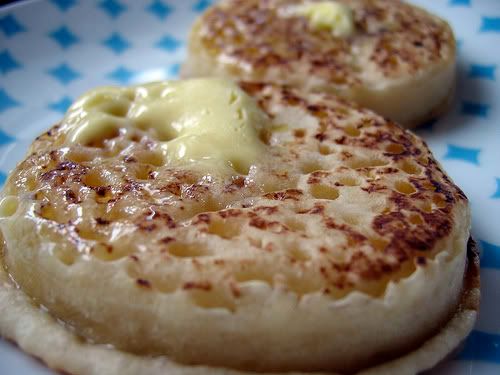
photo by daveknapik.
photo by girlygoogal.
My recent rereading of the novel yielded new insights about the self sufficiency of manor houses like Misselthwaite during Victorian times, and Burnett's advocacy of homegrown and lovingly shared food as a key component in establishing physical and emotional health. We see Mary change from a sickly, sallow, ill-tempered waif, to a happy, engaged, more caring individual. Colin undergoes a dramatic transformation from a pessimistic, overprotected, bedridden tyrant to a budding evangelical Christian scientist. Purposeful activity centered around nature, lots of fresh air, exercise and companionship certainly contributed to healing, but so did unlimited access to a bounty of locally sourced nourishment.
You may remember that the first time Mary wandered outside, she met Ben Weatherstaff, who was working in one of the kitchen gardens. A place like Misselthwaite probably had at least three kitchen gardens (averaging between 1-1/2 to 5 acres each) and an orchard, which supported a large variety of fruit, vegetables, and herbs. The high brick garden walls kept out thieves and large animals, and helped keep the heat in. Some of the vines and fruit trees were trained to grow on the walls for maximum exposure to light and warmth, thereby increasing their yield.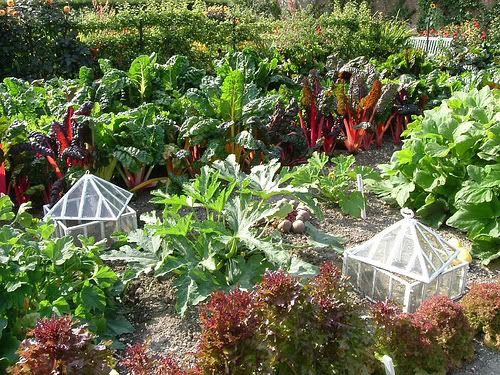
Victorian cloches at West Dean Kitchen Garden protect against cold and pests.
(photo by ANDREWPF)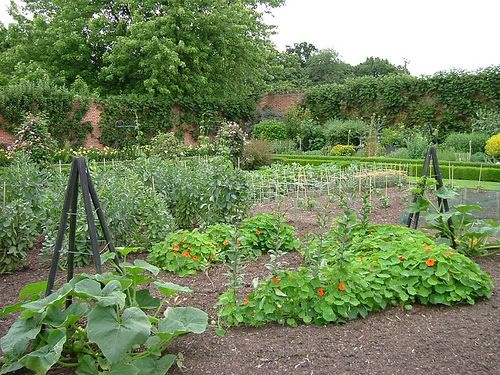
Felbrigg Kitchen Garden photo by ANDREWPF.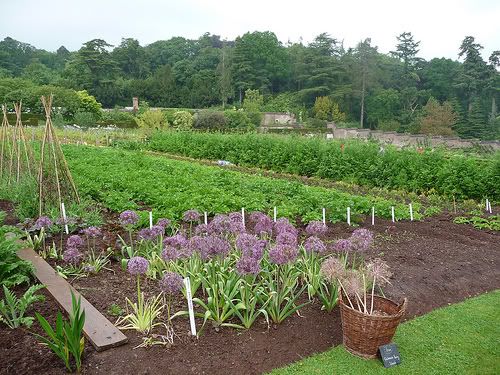
Photo of walled kitchen garden at Knightshayes Court by rmtw. 
Rhubarb garden at Knightshayes Court (Tiverton, Devon, England).
(photo by rmtw.)
Mrs. Loomis, the cook, consulted with the head gardener, Mr. Roach, about what to plant, and made sure the larder and pantries were stocked with all the ingredients necessary to feed the family, staff, and guests. She also supervised the cooking of breakfast, luncheon, tea, and dinner. It is likely the manor raised its own dairy cows and chickens, or ordered milk and poultry from local farmers.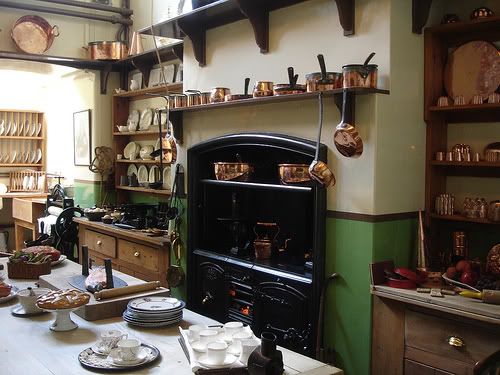
Beaulieu Palace kitchen photo by Antony Smith.
By contrast, Dickon's family, who lived in a small four-room cottage a few miles away, struggled with getting enough food on a daily basis. Susan Sowerby had fourteen mouths to feed; their mainstays included porridge, breads, the occasional bacon, and whatever Dickon grew in their small garden -- practical, sturdy vegetables like potatoes, turnips, carrots, cabbages and herbs that could stand up to the harsh Yorkshire weather and be easily stored for the winter. Not a crumb was ever wasted or taken for granted, so that's why Martha was so shocked when Mary refused to eat her porridge her first morning at Misselthwaite (do you remember what she did end up eating?). Since they couldn't afford the brick walls of manor houses, cottagers like the Sowerbys constructed stone walls to buffer the wind and guard against animals.
But whether the children feasted on Mrs. Loomis' meals or Susan's currant buns, they thrived -- grew fatter, stronger, and more energetic, because the food was always made from fresh ingredients and shared among friends. The most delightful meals took place in the secret garden itself, on occasions when Dickon brought along a pail of fresh milk, and whatever baked goods his mother could spare that day. That she was willing to share what little food they had speaks highly of the generosity of country folk, and is in keeping with Burnett's idealized vision of pastoral bliss in the face of poverty. In this story, those who had the least seemed happiest, while Colin and Mary, who came from privileged backgrounds, suffered from neglect. Though Mary probably could have had anything she asked for at the manor, I'm guessing she relished those warm currant buns wrapped in a clean blue and white napkin. 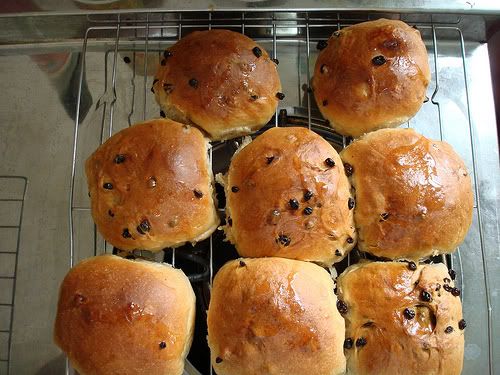
Currant buns by Evanswood.
My memories of Yorkshire food are unequivocally positive. While in London, we mostly ate at ethnic restaurants -- Japanese, Indian, Korean, and Italian, because English food, other than breakfast, was largely disappointing. But when we traveled up north, the food vastly improved. Was it the bracing country air, the farm fresh produce, the friendly people, or the romance of being in the culturally rich shire associated with the Brontës, James Herriot, Evelyn Waugh's Brideshead Revisited, children's author Arthur Ransome, or poets W.H. Auden and Ted Hughes? 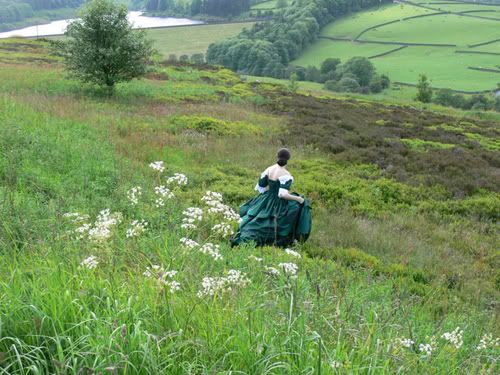
Haworth moors, Brontë Country (photo by Abigail 709b).
Yorkshire fare is simple, hearty, and rich with flavor -- comfort food designed to keep the body and spirits braced against a damp, harsh climate and adequately fueled for a hard day's labor. You've probably heard of Yorkshire Pudding, which is like a popover cooked in meat drippings. Though many restaurants now bake individual puddings, served along with the Sunday roast and vegetables, traditionally Yorkshire Pudding is baked in large rectangular pans, sliced into squares, and then served with gravy before the rest of the meal.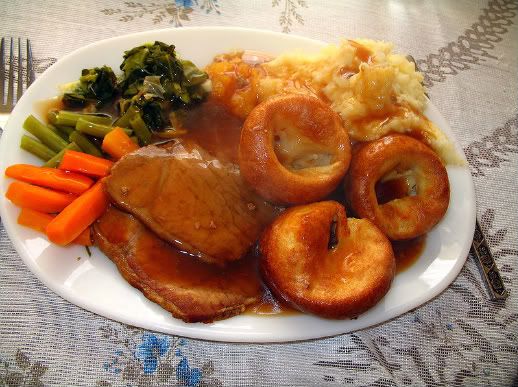
photo by Robbie Jim.
What else is Yorkshire known for? Cured ham, Wensleydale cheese, and a raft of baked goods (one needs extra energy roaming those heathland moors for the likes of Heathcliff).
There's parkin, an oatmeal ginger cake sweetened with treacle,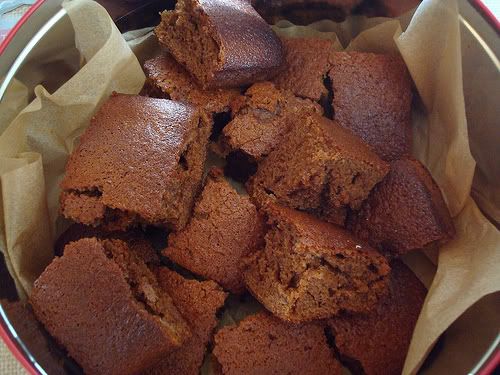
photo by Spider.Dog.
fat rascals, small cakes similar to scones containing dried fruit,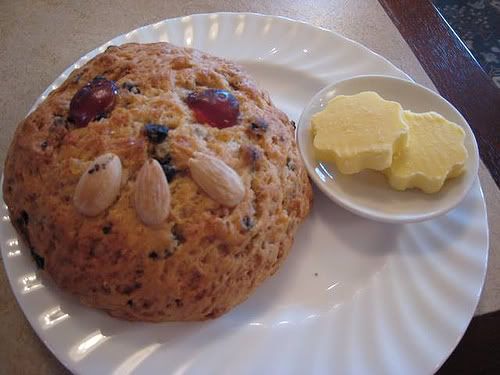
photo by skyoasis.
stottie cakes, a kind of flat bread used for sandwiches,
Wilfra apple cake, which is made with Wensleydale cheese,
singin'hinny, a lard-based pastry that whistles when it bakes, due to its high fat content,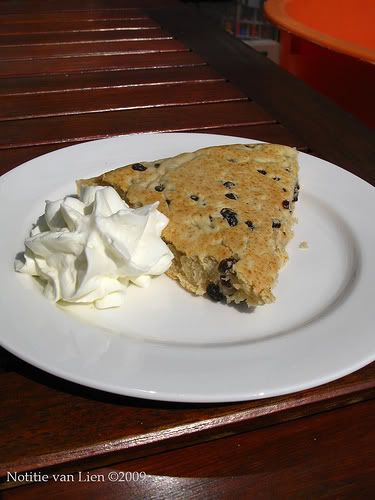
photo by Lien (nottie van Lien)
and Yorkshire curd tarts (made with rosewater).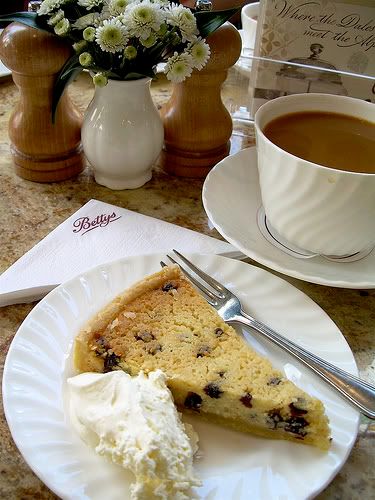
Yorkshire Curd Tart at Betty's Tea Shop (York, England)
(photo by elb_the_prof)
Then there's the famous Yorkshire oatcake, also known as havercake. Along with bread and currant buns, oatcakes were a staple in the Sowerby home, cooked in large quantities on a bakestone suspended by a hook over the fire. Some were enjoyed hot and buttered, while others were left to cool and crisp, propped up on wooden blocks or hung near the ceiling of the cottage so they could be eaten later. At one point in the story, Dickon suggests that Mary visit the cottage to have some "o' Mother's hot oat cake, an' butter an' a glass o' milk." Mmmmm!
Of course I had to try making some of my own. I love pancakes in general, but never made any using oat flour. The recipe from Inside the Secret Garden calls for a blend of whole wheat flour and finely ground oatmeal and yeast! It was easy to make, though you need to plan ahead, since the batter has to rise for about an hour before cooking on a griddle. Of course, the bears ate them with marmalade, raspberry jam, and maple syrup. Oatcakes can also be rolled and stuffed with savory fillings like cubed ham or cheese. I do like this recipe and will definitely make it again.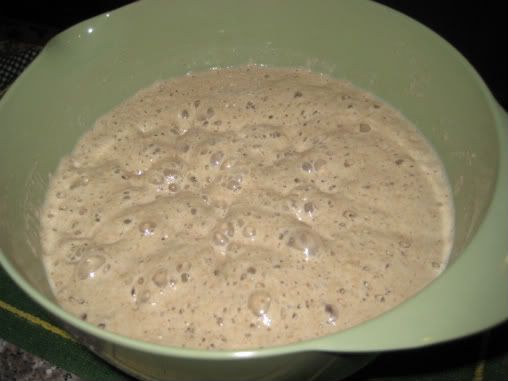
Oatcake batter after one hour's rising.
MOTHER'S HOT OATCAKE
(makes 6 oatcakes)
Cornelius tries one out with butter and marmalade.
1 cup milk
1 cup water
1 oz. fresh yeast (or 2-1/4 tsp. active dry yeast and 1 tsp. sugar)
1-1/2 cups finely ground oatmeal
1/2 cup whole wheat flour
1 tsp. salt
2 tsp. shortening (for greasing the griddle)
1. In a saucepan, mix the milk and water. Set the saucepan over low heat until the mixture is lukewarm to the touch, or 110 ° F if you are using a cooking thermometer.
2. Pour the warmed mixture into a large mixing bowl. Crumble the fresh yeast into the warm milk and water and stir it until it is dissolved. If you are using dry yeast, stir it and the sugar into the warm liquid and set it aside in a warm place for about five minutes, or until the mixture begins to thicken and bubble, before proceeding.
3. Stir the oatmeal, flour, and salt into the milk and yeast mixture. Add more water, if necessary, to make a batter. Cover the bowl with a damp towel or plastic wrap and set it aside in a warm place for about an hour.
4. Lightly grease a griddle or large skillet and place it over medium heat.
5. Stir the oatcake batter and spoon about 2/3 cup of it into the hot pan, spreading it slightly to make a thin oval cake in the middle of the pan.
6. Cook the oatcake for just a few minutes, until it is set but not browned on the bottom. Turn the oatcake and cook it briefly on the other side.
7. Serve the oatcake hot, letting each person break off a piece for herself. Spread the oatcake with butter and jam or marmalade, if desired. Dry any leftover loaves on a wire rack, store them covered, and eat them later, plain or with cheese.
Hmmm, would raspberry jam be better?
I think fresh raspberries and whipped cream is probably best!
♥ Needless to say, when I made this, there were no "leftover" oatcakes to dry. I found these light, fluffy and flavorful -- better than pancakes made with all purpose flour. And it was exciting watching the batter bubble up! I can see how much Mary would be comforted and satisfied eating these in the Sowerby cottage, cheered on by a tribe of boisterous children. I am now anxious to make some parkin and fat rascals, since I've already tasted Yorkshire Pudding and curd tarts.
Interesting that The Secret Garden was written during a time when many poverty-stricken children, who were forced to move to industrial towns for work, lacked proper nourishment, sometimes even fresh drinking water. Burnett created an ideal world where children, rich and poor, had access to fresh food. This story celebrates the wonders that can happen when it is generously and joyously shared.
CHECK THESE OUT: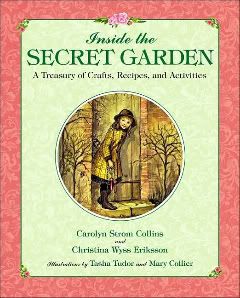
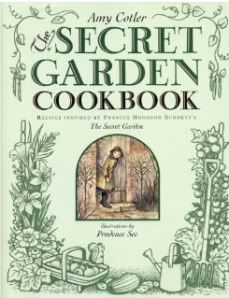
Inside the Secret Garden: A Treasury of Crafts, Recipes, and Activities, by Carolyn Strom Collins and Christina Wyss Eriksson (HarperCollins, 2001). In addition to great recipes for breakfasts and teas, it contains chapters devoted to garden crafts and background about Frances Hodgson Burnett, Misselthwaite Manor, and the language used in the novel.
The Secret Garden Cookbook by Amy Cotler, illustrations by Prudence See (HarperCollins, 1999). Recipes for Yorkshire Breakfasts, A Manor Lunch, An English Tea, The Kitchen Garden, Dickon's Cottage Food, A Taste of India, and Garden Picnics. Also contains juicy tidbits about Victorian cuisine and excerpts from the novel.
Recipes for Yorkshire Pudding, Wilfra Apple Cake, Fat Rascals, and Ginger Parkin can be found online here. Recipe for Singin'hinny is here.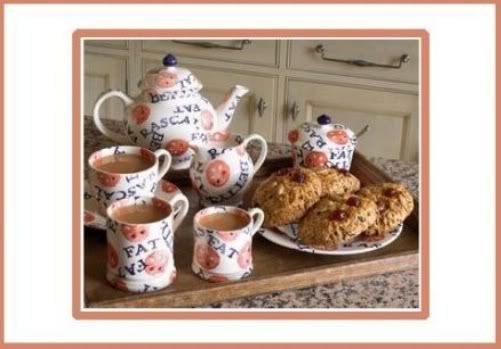
Thanks for reading, and have a Yorkshire Secret Garden kind of day!
The Secret Garden (Part One): Another Peek Inside can be found here.
*Victorian Kitchen illustration used with permission, copyright © 2009 John Shipperbottom. All rights reserved.


